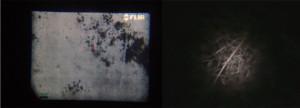Some updates on the project, we managed to spot 30 different individuals for a total number of 46 sighting. This number doesn’t include all the lorises already collared at the field site as our occupancy area is not in the same place. We have half of our spotting on our occupancy points and half on the trails between each point. This is a really good number and we still have two weeks to found out more.
Most of the time when a loris is spotted with the thermal camera we manage to see the loris or at least the eye of loris. But a few times such as this week we had the perfect spot when we manage to see the loris with the camera but no visual at all. The bamboo patch was totally covering and the loris was higher on the canopy. It is in situations like these that the camera is really useful as it allows us to spot animals we would have never seen otherwise. You can see this on the picture of the same spot taken with a night vision camera to show you what we normally see at night, and the view from the thermal camera. It is so amazing as there is no way to spot an animal visually when he is on top of the vegetation. We could perfectly identify the loris by the way it is moving in the tree. At the beginning it was hard to distinguish between all the different animals. But now with some practice it is easy to see the difference between a loris, a rat, a bat and birds.

- Priscillia Miard, LFP Researcher
